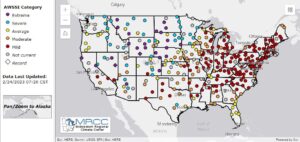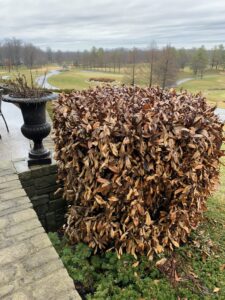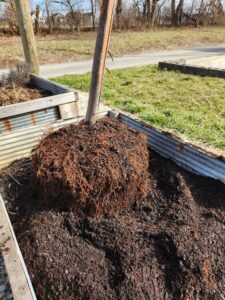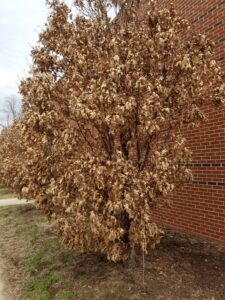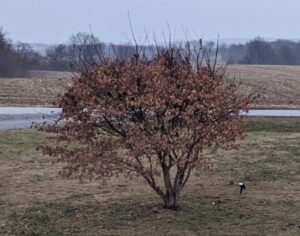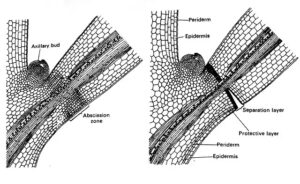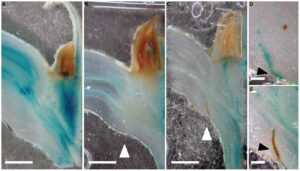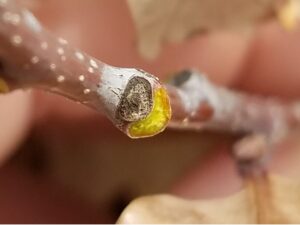Remember the pre-Christmas freeze? What about the extremely long fall? The Midwest experienced above-average temperatures through most of the winter, but those extremely cold temps in late December made for more than a few pipes to freeze in the southern part of the Midwest.
The dichotomy in weather patterns over the last several years has been mind-boggling. We’ve gone from flooding to drought in most recent growing seasons, to the extremes in temperatures this winter. Though it’s an inconvenience for us, plants don’t have the option of heated seats or umbrellas, thus stress or death can occur in these extremes.
- Figure 1. Accumulated Winter Season Severity Index for winter 2022-2023 in the United States from the Midwest Regional Climate Center. https://mrcc.purdue.edu/research/awssi/indexAwssi.jsp
East of the Mississippi River, the 2022-2023 winter has been significantly milder than average, based on past climate models (Fig. 1). We don’t typically have cold injury in late December, but drastic changes in temperatures can cause pernicious effects on plant health. The entire state of Indiana had the drastic changes in temperature December 22-27, 2022 (Table 1).
- Table 1. The high and low temperatures (F) in Evansville, Indianapolis, and Fort Wayne December 22-27, 2022. Data courtesy of the National Weather Service.
There’s on-going evidence of damage across the Midwest from the late/long fall and extreme cold that was experienced in mid-late December. We’ve observed some perennial evergreens, i.e., American holly, Meserve holly (Fig. 2), and skip laurel (Fig. 3), damaged or killed during this winter, especially in the southern parts of the Midwest. In addition, some deciduous trees have significant bark cracking (Fig. 4). Though these plants are hardy well below the temperatures that were experienced, the maximum dormancy wasn’t yet reached by plants due to the warm temperatures so late into the winter season.
- Figure 2. A planting of Meserve hollies died during the winter of 2022-2023 due to cold injury. Photo via Gabriel Gluesenkamp.
- Figure 3. Skip laurel death due to cold injury in 2022-2023. Photo via Tom Creswell.
- Figure 4. Many trees, especially in the nursery, have experienced significant cracking in the winter of 2022-2023. Photo via Erick Brehob.
Plants survive through the winter by entering a phase of dormancy in which the plant is in a state of suspended animation. The dormancy process in plants is a complicated series of internal events caused by external events, that allow perennial plants to protect themselves during environmental changes, such as winter.
Endodormancy and ecodormancy are the stages of dormancy in which the plant has ceased growing. These processes use short days and environment to enter and exit dormancy. Endodormancy includes induction, maintenance, and release. Induction is the process that starts dormancy and is triggered from the reduction in daylight hours, followed by decreasingly cold temperatures to achieve maximum cold hardiness. Maintenance is the accumulation of chilling hours throughout the winter. Release occurs when the number of chilling hours has been fulfilled, thus entering ecodormancy. While endodormancy has internal requirements prior to exit dormancy, ecodormancy is mediated by environmental factors and can come out of dormancy once the environmental (i.e., temperatures) is suitable to resume growth.
An interesting phenomenon that I noticed in late fall/early winter was the length of time plants held onto leaves in the fall of 2022. Fall color came and went, but many species held onto the leaves long after leaves turned brown. Some species have a tendency to hold onto leaves throughout the winter, especially juvenile oaks (Fig. 5), but many other species exhibited similar attributes over the past winter season (Fig. 6).
- Figure 5. A juvenile oak will typically retain leaves throughout the winter due to the incomplete leaf abscission.
- Figure 6. Japanese maple leaf retention.
I suspect that the long fall delayed the abscission layer from fully forming until much later than normal. Leaf abscission and senescence are processes that occur in plants due to multiple factors, including response to dormancy, shade avoidance, and compartmentalizing injury/disease. Abscission and senescence rid a plant of individual leaves for the overall well-being of the entire organism. During this process, an abscission zone forms with a protective layer of suberized cells to seal off the separated portion of the senesced leaf and petiole (Figs. 7, 8, and 9). This process prevents winter injury from occurring.
- Figure 7. Leaf abscission formation and separation.
- Figure 8. White arrow heads point to the abscission zones. (E) Mature abscission zone appears in brown; GUS precipitate in blue. Scale bars correspond to approximately 1 mm (A–C); 0,5 mm (D,E). Black arrowheads point to the forming (D) and mature abscission zone (E). Image via Jin, et.al. (2015).
- Figure 9. Abscission layer with suberized cells on oak.
So, what should we expect?
In the coming few weeks:
- As weather warms, expect calls from homeowners regarding overwintering problems.
- As bud break begins, marginally cold hardy plants may have dead branches.
- If root damage has occurred, bud break may occur normally, but defoliation will follow due to a reduction in the ability to uptake water.
- If possible, wait to prune until after bud break so that dead branches can be removed.
- According to the National Phenology Network (https://www.usanpn.org/usa-national-phenology-network), spring is about three weeks early in the Southeast. If trends continue, bud break and flowering will be very early in the Midwest. This will increase the chances of late frost/freeze damage to plants. As of publication, magnolia are in bloom in the southern half of Indiana. Expected low temperatures will most likely freeze the blooms.
- Plants that have experienced damage from the winter will need to be watched carefully throughout this growing season to prevent other stresses, including drought.
Remember, if you have symptoms on plants you manage, the Purdue Plant and Pest Diagnostic Laboratory is a great resource to ensure the causes of plant problems. You can learn how to submit samples here: https://ag.purdue.edu/department/btny/ppdl/
Related articles:
Effects of Recent Cold Temperatures on Plants
https://www.purduelandscapereport.org/article/effects-of-recent-cold-temperatures-on-plants/
Effect of Cold Temperatures During Bud Break
https://www.purduelandscapereport.org/article/4227/
What do Trees Do in the Winter
https://www.purduelandscapereport.org/article/what-do-trees-do-in-the-winter/
Winter Injury Could Cause a Reduction of Flowering on Perennial Trees and Shrubs
2020 Has Jumped the Shark!
https://www.purduelandscapereport.org/article/2020-has-jumped-the-shark/
Winter Injury Update to Michigan Trees and Shrubs
https://www.purduelandscapereport.org/article/winter-injury-update-to-michigan-trees-and-shrubs/
References:
Jin, X., Zimmerman, J., Polle, A., and Fischer, U. 2015. Auxin is a long-range signal that acts independently of ethylene signaling on leaf abscission in Populus. Front. Plant Sci. Volume 6.
